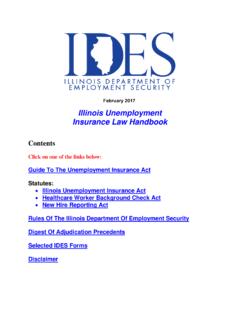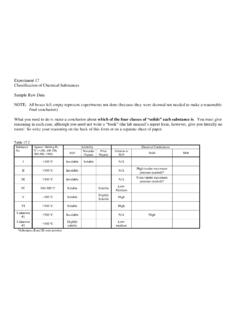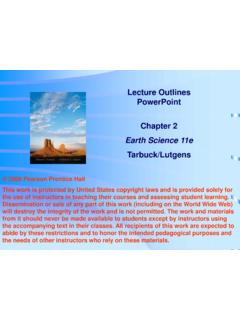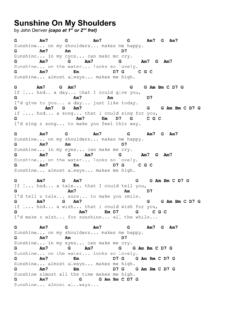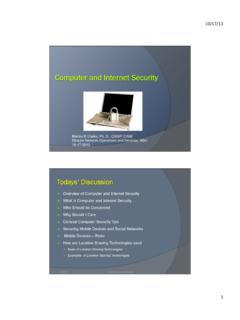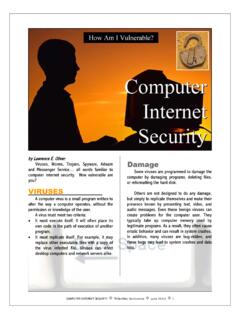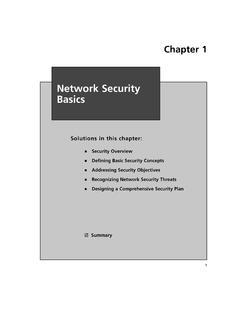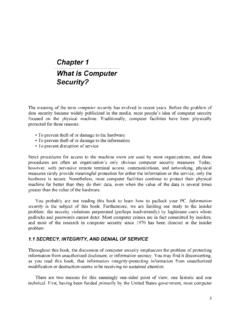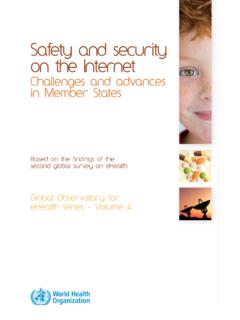Transcription of Chapter 9: Network and Internet Security
1 Deborah Morley Charles S. Parker 15th Edition Understanding Computers Today and Tomorrow Comprehensive Copyright 2015 Cengage Learning Chapter 9: Network and Internet Security Learning Objectives why computer users should be concerned about Network and Internet Security . several examples of unauthorized access and unauthorized use. several ways to protect against unauthorized access and unauthorized use, including access control systems, firewalls, and encryption. several examples of computer sabotage. how individuals and businesses can protect against computer sabotage. Understanding Computers: Today and Tomorrow, 15th Edition 2 2 Learning Objectives online theft, identity theft, spoofing, phishing, and other types of dot cons. steps an individual can take to protect against online theft, identity theft, spoofing, phishing, and other types of dot cons. personal safety risks associated with Internet use.
2 Steps individuals can take to safeguard their personal safety when using the Internet . the current state of Network and Internet Security legislation. Understanding Computers: Today and Tomorrow, 15th Edition 3 Overview This Chapter covers: Security concerns stemming from the use of computer networks and the Internet in our society Safeguards and precautions that can be taken to reduce the risk of problems related to these Security concerns Personal safety issues related to the Internet Legislation related to Network and Internet Security Understanding Computers: Today and Tomorrow, 15th Edition 4 4 Why Be Concerned About Network and Internet Security ? computer Crime (cybercrime) Any illegal act involving a computer , including: Theft of financial assets Manipulating data for personal advantage Act of sabotage (releasing a computer virus, shutting down a Web server) Phishing and Internet scams All computer users should be aware of Security concerns and the precautions that can be taken Understanding Computers: Today and Tomorrow, 15th Edition 5 Unauthorized Access and Unauthorized Use Unauthorized Access Gaining access to a computer , Network , file, or other resource without permission Unauthorized Use Using a computer resource for unapproved activities Both can be committed by insiders and outsiders Codes of Conduct Used to specify rules for behavior, typically by a business or school Understanding Computers.
3 Today and Tomorrow, 15th Edition 6 Unauthorized Access and Unauthorized Use Hacking Using a computer to break into another computer system A serious threat for individuals, businesses, and the country (national Security ), , cyberterrorism Often performed via wireless networks today Many wireless networks are left unsecured War Driving Driving around an area to find a Wi-Fi Network to access and use without authorization Understanding Computers: Today and Tomorrow, 15th Edition 7 Unauthorized Access and Unauthorized Use Wi-Fi Piggybacking Accessing an unsecured Wi-Fi Network from the hacker s current location without authorization Interception of Communications Unsecured messages, files, logon information, etc., can be intercepted using software designed for that purpose New trend: intercept credit and debit card information during the card verification process Packetsniffing software Understanding Computers: Today and Tomorrow, 15th Edition 8 Protecting Against Unauthorized Access and Unauthorized Use Access Control Systems Used to control access to facilities, computer networks, company databases, and Web site accounts Identification Systems Verify that the person trying to access the facility or system is an authorized user Authentication Systems Determine if the person is who he or she claims to be Understanding Computers.
4 Today and Tomorrow, 15th Edition 9 Protecting Against Unauthorized Access and Unauthorized Use Possessed Knowledge Access Systems Use information that only the authorized user should know Typically passwords Passwords should be strong and changed frequently Typically used in conjunction with usernames Disadvantages Passwords can be forgotten If known, password can be used by someone who is not an authorized user Understanding Computers: Today and Tomorrow, 15th Edition 10 Protecting Against Unauthorized Access and Unauthorized Use Understanding Computers: Today and Tomorrow, 15th Edition 11 Protecting Against Unauthorized Access and Unauthorized Use Cognitive Authentication Systems Use information the individual knows or can easily remember (birthplace, pet names, etc.) Used in many password recovery systems Two-Factor Authentication Using two different methods to authenticate users Typically possessed knowledge (password) with either Biometric Feature something you are Possessed Object something you have Hard token physical object used Soft token supplies a one-time password (OTP) Understanding Computers: Today and Tomorrow, 15th Edition 12 Protecting Against Unauthorized Access and Unauthorized Use Understanding Computers: Today and Tomorrow, 15th Edition 13 Protecting Against Unauthorized Access and Unauthorized Use Possessed Object Access Systems Use a physical object an individual has in his/her possession to identify that individual Smart cards, magnetic cards RFID-encoded badges, USB Security keys or tokens Understanding Computers.
5 Today and Tomorrow, 15th Edition 14 Protecting Against Unauthorized Access and Unauthorized Use Disadvantages Can be lost or used by an unauthorized individual Biometric Access Systems Identifies users by a particular unique biological characteristic Fingerprint, hand, face, iris, voice, etc. Data read by biometric reader must match what is stored in a database Understanding Computers: Today and Tomorrow, 15th Edition 15 Protecting Against Unauthorized Access and Unauthorized Use Often used to: Control access to secure facilities Log on to computers, punch in/out at work, law enforcement, etc. Advantages Biometric access systems are very accurate Cannot be lost or forgotten Disadvantages Cannot be reset if compromised Hardware and software are expensive Understanding Computers: Today and Tomorrow, 15th Edition 16 Protecting Against Unauthorized Access and Unauthorized Use Understanding Computers: Today and Tomorrow, 15th Edition 17 Protecting Against Unauthorized Access and Unauthorized Use Controlling Access to Wireless Networks In general, Wi-Fi is less secure than wired networks Security is usually off by default.
6 Wireless networks should be secured Wireless Network owners should: Change the router s default password Enable encryption (WPA2 is more secure than WPA) Enable other Security features as needed Can hide Network name (SSID) Understanding Computers: Today and Tomorrow, 15th Edition 18 Protecting Against Unauthorized Access and Unauthorized Use Understanding Computers: Today and Tomorrow, 15th Edition 19 How It Works Box Securing a Wireless Home Router Use router s configuration screen Be sure to change the access password Enter the SSID name, select the Security mode, and type a secure passphrase Can use MAC filtering Understanding Computers: Today and Tomorrow, 15th Edition 20 Protecting Against Unauthorized Access and Unauthorized Use Firewalls A collection of hardware and/or software intended to protect a computer or computer Network from unauthorized access Typically two-way, so they check all incoming (from the Internet ) and outgoing (to the Internet ) traffic Important for home computers that have a direct Internet connection, as well as for businesses Work by closing down external communications ports Understanding Computers: Today and Tomorrow, 15th Edition 21 Protecting Against Unauthorized Access and Unauthorized Use Understanding Computers.
7 Today and Tomorrow, 15th Edition 22 Protecting Against Unauthorized Access and Unauthorized Use Intrusion Prevention System (IPS) Software Monitors traffic to try and detect possible attacks If an attack is discovered, IPS software can immediately block it Encryption Method of scrambling contents of e-mail or files to make them unreadable if intercepted Secure Web pages use encryption SSL and EV SSL Understanding Computers: Today and Tomorrow, 15th Edition 23 Protecting Against Unauthorized Access and Unauthorized Use Private Key Encryption (symmetric key encryption) Uses a single key Most often used to encrypt files on a computer If used to send files to others, the recipient and sender must agree on the private key to be used Public Key Encryption (asymmetric key encryption) Uses two keys (a private key and a public key) to encrypt and decrypt documents Public key can be given to anyone Key pairs are obtained through a Certificate Authority Understanding Computers: Today and Tomorrow, 15th Edition 24 Protecting Against Unauthorized Access and Unauthorized Use Understanding Computers.
8 Today and Tomorrow, 15th Edition 25 Protecting Against Unauthorized Access and Unauthorized Use Web-based encrypted e-mail (HushMail) is available Various strengths of encryption available Stronger is more difficult to crack Strong = 128-bit (16-character keys) Military = 2,048-bit (256-character keys) Understanding Computers: Today and Tomorrow, 15th Edition 26 Protecting Against Unauthorized Access and Unauthorized Use Virtual Private Networks (VPNs) A private secure path over the Internet Allows authorized users to securely access a private Network via the Internet Much less expensive than a private secure Network Can provide a secure environment over a large geographical area Typically used by businesses to remotely access corporate networks via the Internet Personal VPNs can be used by individuals to surf safely at a wireless hotspot Understanding Computers: Today and Tomorrow, 15th Edition 27 Protecting Against Unauthorized Access and Unauthorized Use Additional Public Hotspot Precautions Individuals should take additional precautions when using public hotspots in addition to using Security software, secure Web pages, VPNs, and file encryption Understanding Computers.
9 Today and Tomorrow, 15th Edition 28 Protecting Against Unauthorized Access and Unauthorized Use Sensible Employee Precautions Screen potential new hires carefully Watch for disgruntled employees and ex-employees Ask business partners to review their Security Develop policies and controls Use software to manage devices and prevent data leaks Data leakage prevention systems Outbound-content monitoring systems Mobile device management (MDM) - BYOD Understanding Computers: Today and Tomorrow, 15th Edition 29 Protecting Against Unauthorized Access and Unauthorized Use Understanding Computers: Today and Tomorrow, 15th Edition 30 Inside the Industry Box Securing BYOD BYOD = Bring Your Own Device Some businesses use BYOD as a cost-saving measure Individuals want to carry their devices with them and use for both work and personal use Security is a disadvantage Businesses need to ensure company networks and data are not adversely affected MDM software can help Containerization can separate work and personal data and apps Understanding Computers: Today and Tomorrow, 15th Edition 31 Quick Quiz 1.
10 Which of the following is an example of possessed knowledge? a. Password b. Smart card c. Fingerprint 2. True or False: With public key encryption, a single key is used to both encrypt and decrypt the file. 3. A(n) _____ controls access to a computer from the Internet and protects programs installed on a computer from accessing the Internet without authorization from the user. Answers: 1) a; 2) False; 3) firewall Understanding Computers: Today and Tomorrow, 15th Edition 32 computer Sabotage computer Sabotage Acts of malicious destruction to a computer or computer resource Launching a computer virus Denial of Service (DoS) attack Botnet A group of bots (computers controlled by a hacker) that are controlled by one individual and work together in a coordinated fashion Used by botherders (criminals) to send spam, launch Internet attacks, and spread malware Understanding Computers: Today and Tomorrow, 15th Edition 33 computer Sabotage Malware Any type of malicious software Written to perform destructive acts (damaging programs, deleting files, erasing drives, etc.

